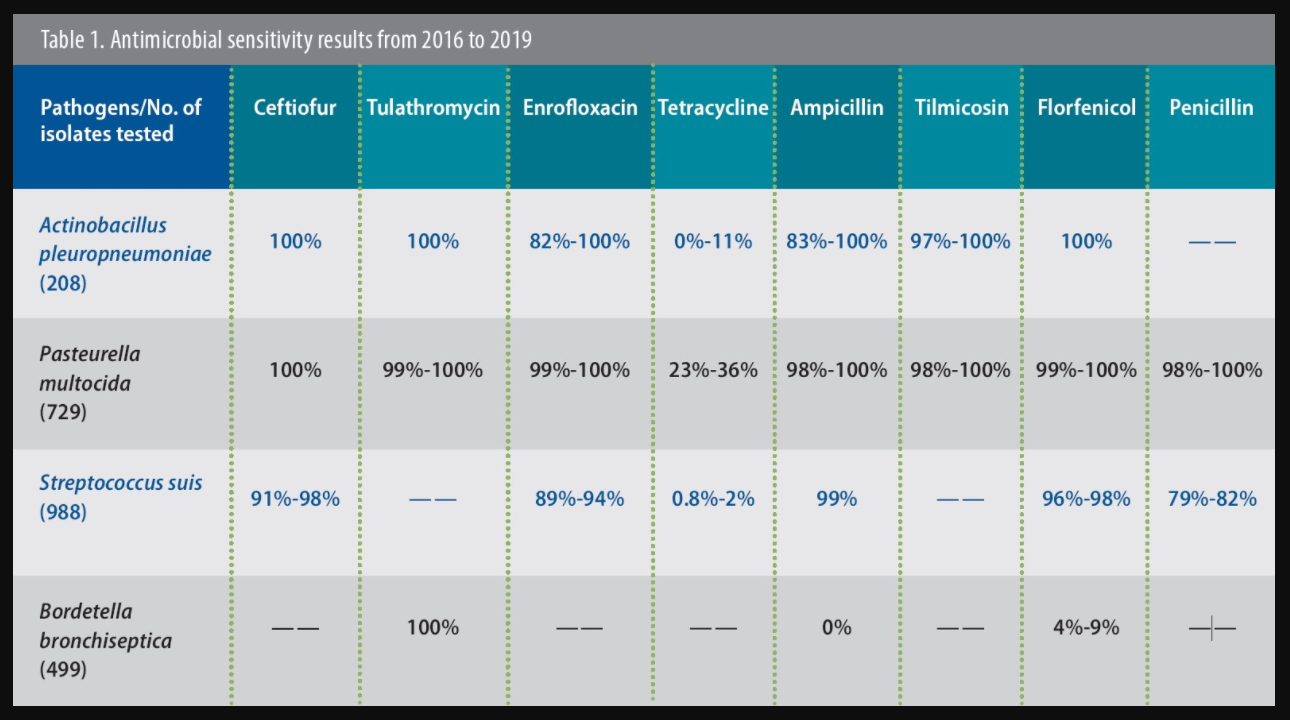



SRD pathogens remain highly susceptible to key antimicrobials
Pathogens commonly associated with swine respiratory disease (SRD) remain highly susceptible to key veterinary antimicrobials, according to the latest results from a Zoetis surveillance program.1The highest rates of susceptibility were found with Actinobacillus pleuropneumoniae isolates, which were all 100% susceptible to ceftiofur, tulathromycin and florfenicol, said Michael Sweeney, senior principal scientist, Zoetis.
All Pasteurella multocida isolates were also 100% susceptible to ceftiofur, and all Bordetella bronchiseptica isolates were 100% susceptible to tulathromycin (Table 1), Sweeney said.
There were a couple of exceptions, he reported. A. pleuropneumoniae, P. multocida and Streptococcus suis had low susceptibility to tetracycline, and B. bronchiseptica was completely resistant to ampicillin and had low susceptibility to florfenicol.
These latest results are based on testing of more than 2,400 isolates from 2016 to 2019. However, the rates of susceptibility are similar to what has been observed over the past 21 years of the Zoetis surveillance program, Sweeny said, and added that “little to no multi-drug resistance has been found.”
Supports responsible antimicrobial use
The Zoetis surveillance program, initiated in 1998, annually collects and analyzes isolates obtained from geographically diverse veterinary diagnostic laboratories in the US and Canada. The isolates are from animals with naturally occurring SRD.
Susceptibility is determined based on the minimal inhibitory concentration (MIC) — the lowest concentration of each antimicrobial that prevents visible growth of a bacterium. Testing is conducted with strict adherence to the Clinical and Laboratory Standards Institute (CLSI) standardized methods.
“We crunch the data down to MIC50 and MIC90 values, and to susceptible, intermediate or resistant , based on available CLSI-endorsed breakpoints,” Sweeney said. The results, presented to the FDA’s Center for Veterinary Medicine, are also shared with the laboratories that provide the isolates, at veterinary conferences and are periodically published in veterinary journals.
Surveillance helps identify resistance trends and fosters an improved understanding of antimicrobial resistance. It also supports responsible antimicrobial use, Sweeney said.
Encouraging results
“Within our advanced surveillance program at Zoetis, we continue to see low resistance in the pig sector, and that’s in contrast to findings among other types of livestock, where we find higher rates of antimicrobial resistance,” he said.
Asked why there’s low resistance among SRD pathogens affecting swine, Sweeney said he doesn’t know the answer but thinks it might be due to management and perhaps all-in/all-out production practices. It may also be a reflection of the swine industry’s commitment to the responsible use of antimicrobials, which Sweeney said he finds “very encouraging.”
| References | ||||
|---|---|---|---|---|
| 1 Data on file. Study Report No. A671Z-US-19-165. Zoetis, LLC | ||||










